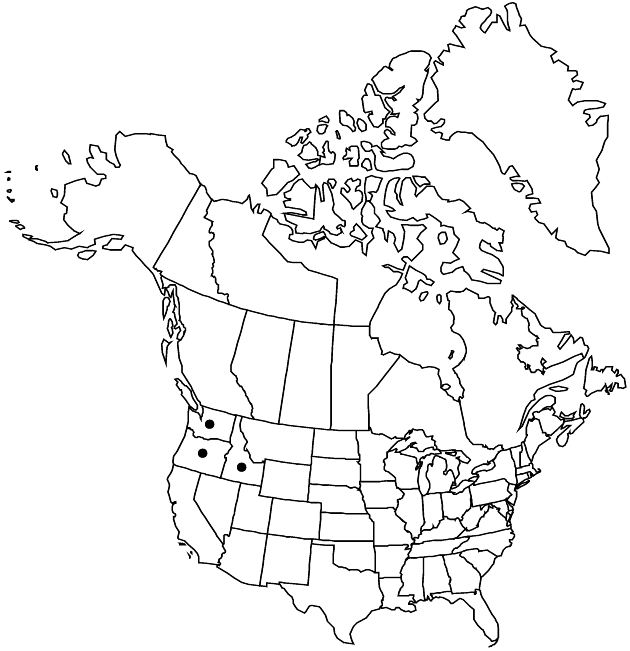Difference between revisions of "Erigeron disparipilus"
Brittonia 6: 194. 1947.
FNA>Volume Importer |
imported>Volume Importer |
||
| (6 intermediate revisions by 2 users not shown) | |||
| Line 8: | Line 8: | ||
}} | }} | ||
|common_names=White cushion fleabane | |common_names=White cushion fleabane | ||
| + | |special_status={{Treatment/ID/Special_status | ||
| + | |code=E | ||
| + | |label=Endemic | ||
| + | }} | ||
|basionyms= | |basionyms= | ||
|synonyms= | |synonyms= | ||
| Line 24: | Line 28: | ||
|elevation=600–2000(–2200) m | |elevation=600–2000(–2200) m | ||
|distribution=Idaho;Oreg.;Wash. | |distribution=Idaho;Oreg.;Wash. | ||
| − | |discussion=<p>Erigeron disparipilus is similar to E. nanus but less variable. The range of E. disparipilus barely contacts that of E. nanus in southeastern Idaho and they have different ecologies; blue rays of E. disparipilus in Owyhee County may indicate that hybridization occurs.</p> | + | |discussion=<p><i>Erigeron disparipilus</i> is similar to <i>E. nanus</i> but less variable. The range of <i>E. disparipilus</i> barely contacts that of <i>E. nanus</i> in southeastern Idaho and they have different ecologies; blue rays of <i>E. disparipilus</i> in Owyhee County may indicate that hybridization occurs.</p> |
|tables= | |tables= | ||
|references= | |references= | ||
| Line 33: | Line 37: | ||
-->{{#Taxon: | -->{{#Taxon: | ||
name=Erigeron disparipilus | name=Erigeron disparipilus | ||
| − | |||
|authority=Cronquist | |authority=Cronquist | ||
|rank=species | |rank=species | ||
| Line 47: | Line 50: | ||
|publication title=Brittonia | |publication title=Brittonia | ||
|publication year=1947 | |publication year=1947 | ||
| − | |special status= | + | |special status=Endemic |
| − | |source xml=https:// | + | |source xml=https://bitbucket.org/aafc-mbb/fna-data-curation/src/2e0870ddd59836b60bcf96646a41e87ea5a5943a/coarse_grained_fna_xml/V19-20-21/V20_587.xml |
|tribe=Asteraceae tribe Astereae | |tribe=Asteraceae tribe Astereae | ||
|genus=Erigeron | |genus=Erigeron | ||
Latest revision as of 21:04, 5 November 2020
Perennials, 3–12 cm; taprooted, caudices branched. Stems erect, densely pilose to hirsute or villoso-hirsute (hairs usually slightly ascending, loose, often mixed in orientations, of unequal lengths, relatively thin-based), eglandular. Leaves mostly basal (persistent), (petioles prominently ciliate, hairs thick-based, spreading); blades linear to linear-oblanceolate, 20–40 × 1–2 mm, margins entire, faces finely hirsute, eglandular; cauline reduced, restricted to proximal 1/3 of stems. Heads 1. Involucres 5–7 × 8–16 mm. Phyllaries in 2–3 series, hirsute to hirsuto-strigose, minutely glandular. Ray florets mostly 30–60; corollas usually white, sometimes fading pink, rarely blue, 5–10 mm, laminae loosely coiling. Disc corollas 2.8–4 mm. Cypselae 1.8–2.2 mm, 2-nerved, faces moderately, loosely strigose; pappi: outer of setae, inner of 15–25 bristles.
Phenology: Flowering May–Aug.
Habitat: Gravelly and rocky slopes, ridges, sagebrush, grassland
Elevation: 600–2000(–2200) m
Distribution

Idaho, Oreg., Wash.
Discussion
Erigeron disparipilus is similar to E. nanus but less variable. The range of E. disparipilus barely contacts that of E. nanus in southeastern Idaho and they have different ecologies; blue rays of E. disparipilus in Owyhee County may indicate that hybridization occurs.
Selected References
None.